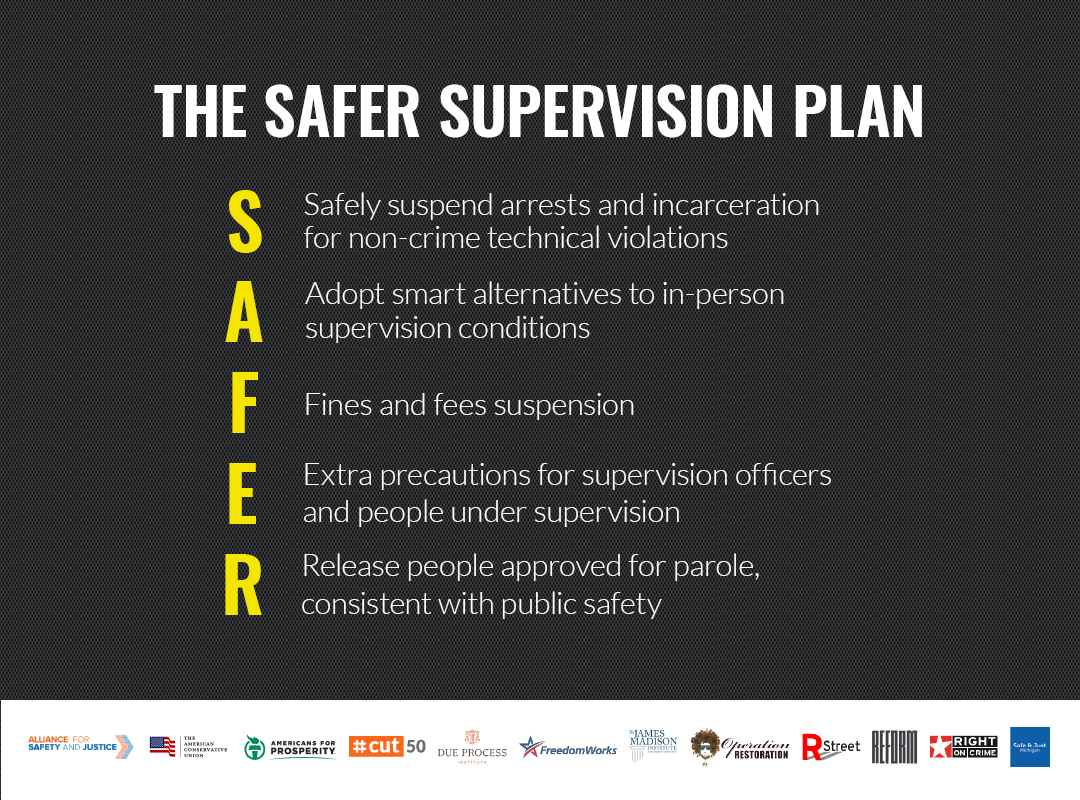THE SAFER SUPERVISION PLAN: A SAFER WAY TO REOPEN AMERICA

Organizations endorsing SAFER plan
The United States incarcerates over 2.3 million people in prisons and jails and exercises correctional control over another 4 million people through community supervision, with approximately 1 in every 55 adults on probation or parole1. Recent data has shown that people in our jails and prisons, those living in transitional houses, and those under community supervision – as well as the correctional staff, parole and probation officers, and law enforcement that work with them – are especially vulnerable to the
COVID-19 coronavirus.
With many jails and prisons operating well over capacity with cramped and unsanitary conditions, correctional facilities have become epicenters of coronavirus illness and death. As of early May, four of the five biggest U.S. coronavirus hotspots were prisons. And, the rate of COVID-19 spread and infection will continue to increase behind bars unless essential prevention and containment measures are implemented.
For example, recently, nearly 80% of those incarcerated at the Marion Correctional Institute in Marion County, Ohio tested positive for the virus. In Elayn Hunt Correctional Center in Louisiana, nearly every incarcerated woman (192 out of 195) and 41 correctional staff tested positive for COVID-194. Additionally, more than 5,000 correctional officers have tested positive for COVID-195, and a number of other correctional staff and administrators – such as prison wardens, medical directors, and counselors – have died from the virus.
COVID-19 has spread much faster behind bars than in the general community. But because our prisons and jails are mostly hidden from the day-to-day activities of the larger community, the increasing rates of COVID-related sickness and death behind bars can seem separate from the overall health and well-being of the rest of the community. But nothing could be farther from the truth.
Correctional staff commute between their communities and correctional facilities, increasing the likelihood of both bringing the virus in and taking the virus back out of the prison. COVID-19 outbreaks in correctional facilities require scarce medical resources – such as doctors, nurses, medication, medical equipment, and hospital beds – exacerbating the shortage of these essential resources necessary to protect and treat the entire community. Communities that have failed to address COVID-19 outbreaks in densely populated pockets or institutions have seen this blind spot quickly result in a full resurgence of the virus even after successfully eliminating it from the larger community. Thus, the ability to safely reopen America’s communities depends on addressing and treating the outbreaks in its correctional facilities.
It also hinges on ensuring that the millions of people under supervision and the law enforcement and supervision officers who work with them are protected from COVID-19. That is why, building on the SAFER Prevention plan our organizations released in March, we are now issuing the SAFER supervision plan:

Whether by extending and increasing shelter-in-place regulations or easing restrictions and reopening communities, these recommendations support states in all phases of their pandemic response and are essential to making progress in the fight against coronavirus. In particular, this plan will help reduce the spread of COVID-19 among correctional institutions, populations under community supervision, and correctional officers, law enforcement, and the first responders who are called on to save lives.
The policy recommendations contained in the plan are each aimed at increasing public health and public safety outcomes for us all, and are as follows:
Safely Suspend Arrests and Incarceration for Technical Violations Not Involving a New Offense
The high occurrence of COVID-19 and the alarming number of resulting deaths in our correctional institutions require the suspension of any/all nonessential confinement to avoid turning any incarceration sentence into a potential death sentence. The overcrowded and congregate conditions in our correctional facilities make it impossible to abide by lifesaving CDC protocols, such as social distancing and proper hygiene, which exponentially increases the risk of infection and death. Ensuring that people who have not committed crimes, but instead are being held on technical violations, are not incarcerated and/or are safely released to reduce correctional facility overcrowding and increase safety and public health outcomes for communities overall.
Recommendations
Suspend or limit arrests and use of incarceration to address violations of supervision conditions that are unrelated to a new offense and do not create an urgent danger to public safety. Utilize alternative consequences and incentives, such as supervision earned time credits, to address violations that do not pose a threat to public safety. Expedite release of people not a risk to public safety who are incarcerated for technical violations (no new offense).
Adopt Smart Alternatives to In-Person Supervision Conditions
Remote fulfillment of basic supervision conditions (such as check-ins), have proven to be just as effective for compliance as in-person conditions, and will keep our supervised population, our supervision officers, and our communities as a whole safer by reducing unnecessary movement and contact. Supervision officers should provide comprehensive remote support to people transitioning out of incarceration and into the community during the pandemic to support successful reentry while respecting necessary public health precautions.
Recommendations
Temporarily modify or suspend provisions of state and local codes to the extent permitted by state constitutions and statutes that require in-person attendance as conditions of parole, probation, or mandatory supervised release. Replace traditional in-office visits and group participation with remote alternatives. Provide people under supervision with safe and secure opportunities to use available technology to comply with remote alternatives. Provide supervision officers and people under supervision with clear guidance and expectations for remote fulfillment of conditions and available remote support to avoid confusion and increase safety.
Fines and Fees Suspension
COVID-19 has brought record high unemployment rates throughout the country, with more than 20.5 million jobs lost in April 2020, bringing the United States into an unprecedented employment crisis.8 Coupled with school closures that require primary caretakers to remain in the home with their children, food shortages and price hikes that make it difficult to provide for basic sustenance, and an increase in medical costs that come with a viral pandemic, financial security has become rare. People under supervision traditionally have lower rates of employment and less savings, putting them at even higher risk for financial ruin as a result of this pandemic
Recommendations
Suspend all fines and fees associated with community supervision and eliminate late fees during this time. Suspend conditions of supervision that require unavailable employment. Consider increased costs, such as medical payments and home-schooling expenses, when analyzing future payment schedules.
Extra Precautions for Supervision Officers and People Under Supervision
Jurisdictions should prioritize alternatives to incarceration and reduce unnecessary supervision terms to appropriately focus resources and attention on those who require assistance. Evidence-based, reasonable limits on supervision terms can prevent counterproductive, lengthy supervision terms that fail to increase public safety outcomes and add to the ballooning and unmanageable caseloads of our supervision officers. Data-driven, effective incentive programs, such as earned time and early termination provisions that reward exemplary performance, can aid jurisdictions in safely reducing supervision terms and conditions for those who have shown that they are neither a threat to public safety nor in continued need of monitoring. As jurisdictions employ alternatives to incarceration to effectively combat the spread of and death from COVID-19 in our correctional facilities, there will be an increased need for supervision officers to monitor and support those who are transitioning into the community, while simultaneously increasing the freedom and independence of those who have demonstrated stability in the community. Accordingly, transitioning more successful individuals off of supervision can free up caseload resources for the increasing numbers of individuals being released from prisons and jails onto supervision.
Recommendations
Increase opportunities for early discharge from supervision for individuals unnecessarily on probation or parole. Jurisdictions should also review their procedures to identify ways to streamline these processes in light of the workload challenges facing courts, such as through a judicial order at the outset of the case that allows probation officers to terminate supervision without a court hearing once the supervisee has completed a significant portion of their term and met certain benchmarks demonstrating their commitment to stability and safety.
Release People Approved for Parole, Consistent with Public Safety
To safely and appropriately create room inside of correctional institutions to allow for life-saving CDC protocols, states must expedite their parole processes to ensure that bureaucratic slowdowns don’t contribute to illness and death.
Recommendations
Expedite decisions on cases found suitable for parole by the Board of Parole, with a presumption of parole and release absent a clear showing of good cause for rejecting the Parole Board’s recommendation. Direct the Board of Parole to consider the use of parole and supervised discharge or early release for people who are currently incarcerated and not a threat to public safety, who are eligible for parole, supervised discharge, or early release within the next six (6) months. Parole boards should consider expediting the evaluation of particularly urgent and meritorious cases of candidates most vulnerable to COVID-19 who have long set-off periods between their prior and upcoming parole reviews. This includes reexamining cases previously denied parole within the last twelve (12) months, to the extent Parole Boards have the power and capacity to do so, to determine if circumstances have changed such that they are now suitable for parole and release. Expedite the safe release of individuals in transition housing who have a viable community residential plan and are within six (6) months of their release date.
It is critical, not only for states that are working to reopen, but those that are still ramping up restrictions, to continue taking lifesaving precautions to prevent the spread and/or resurgence of the coronavirus. Limiting physical contact and unnecessary travel is a proven way to reduce the threat of the virus. Any plan to reopen a state should include solutions from the SAFER Prevention plan, such as releasing vulnerable people from incarceration and protecting first responders, law enforcement, and correctional officers from the virus. But the evidence-based recommendations contained in the new SAFER Supervision plan, such as remote supervision check-ins and alternatives to arrests for noncriminal technical violations, should also be adopted. These measures will help states defend against COVID-19 by protecting supervised individuals and their families, supervision officers, and the general public, alike, from the virus. Fewer infections and hospitalizations will enable states to more quickly allow businesses to reopen and get employees back to work. By prioritizing public safety and public health, this plan provides states with another tool to safely reopen and reduces the threat of the virus to supervised and incarcerated populations, law enforcement and correctional officers, and communities as a whole.
